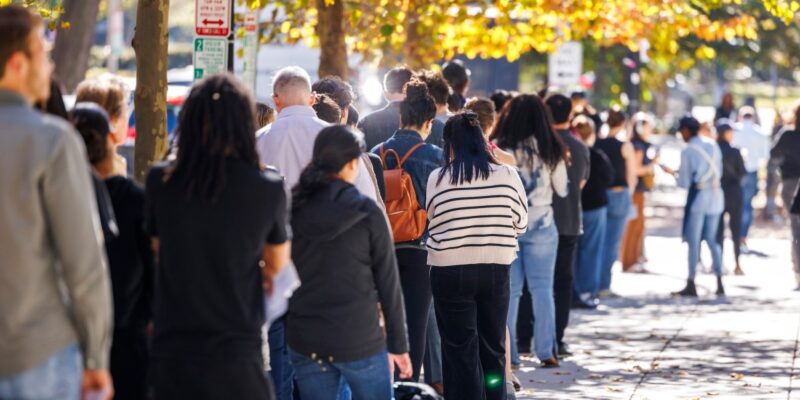
In the days and weeks after the 2020 election, more than 65,000 mail-in ballots were rejected for arriving too late—and given how much is at stake in 2024’s races, nationally and at the state level, it makes sense that American voters would do just about anything to make sure their vote gets counted. For millions of people, that includes waiting in long lines at polling places, sometimes for hours, even at the risk of fainting.
While waiting in line can be exhausting for anyone, it has unique impacts on disabled and chronically ill people. Standing for long periods can send some chronically ill people into weeks-long flares, a trade-off many were willing to make to try to stop a Trump victory—which, especially through the machinations of Project 2025, could greatly hurt disabled people.
The closure (or lack) of polling places is one factor in those wait times, particularly in Black neighborhoods, where the wait to vote is typically already longer. The burden falls disproportionately on disabled and aging Black people; in Texas, for instance, from 2016 to 2018, there were more closures of polling locations in counties where more Latino and Black Texans lived.
Meanwhile, Republicans across the country have launched many lawsuits trying to make the definition of “on time” stricter—which, as my colleague Abby Vesoulis has reported, is part of a bogus GOP strategy to try and turn the election in its favor. It may be working: Just one day before the election, the Georgia Supreme Court ruled that Cobb County could only count ballots received by 7 p.m. local time on Election Day.
When I spoke to Michelle Bishop, the National Disability Rights Network‘s voting access manager, in April, she told me that voting locations should consider “moving people with disabilities to the front of the line” if they cannot stand for long periods. While some polling places do have separate lines for disabled voters, as well as curbside voting, it’s far from uniform.
Rachel Green, who lives in North Carolina’s Davidson County, voted early—like more than half the county’s voters—at a local polling place. In person, they told me, they could trust that their ballot wouldn’t be rejected.
(Charles Stewart, the director of the Massachusetts Institute of Technology’s Election Data and Science Lab, told me that voters shouldn’t have much fear that mail-in ballots won’t be accepted—but that “it is simply a matter of fact that if you take the same person, have them vote in person, and then vote by mail, the mail ballot has a slightly lower chance of being counted.”)
But the wait was physically taxing on Green, who lives with arthritis in their knees and feet. The whole process took two to three times as long—an hour and a half—as in previous years. With invisible disabilities and no blue parking placard, Green didn’t expect to qualify for curbside voting, and there were no seats available, even once they got in. “I’m doing a shuffle from side to side, bending my knees,” they said to me. “People were looking at me funny.” Green thinks there just needed to be more chairs.
Standing isn’t the only challenge in long lines—so are rules against providing voters with food and water, known as “line warming,” which the American Bar Association says “can serve as a tool to make it easier to stay in line so eligible voters who want to vote can cast their ballot.” (Line warming has been illegal since 2021 in Florida, but similar laws have been limited in Georgia, and completely struck down in New York, by federal judges.)
It’s not just Republican-controlled areas that have long lines. In Philadelphia—the largest city in a crucial swing state—Eshani Surya, who lives with ulcerative colitis, had to leave a voting line on Election Day to go to the bathroom during her 45-minute wait. There was no line for disabled voters, and although her husband was there to save her spot, there was no guarantee that she could get back in line.
But, like many others, Surya still elected to vote in person to be involved in the real-life excitement of it all: “There was an energy about being there,” she said.















